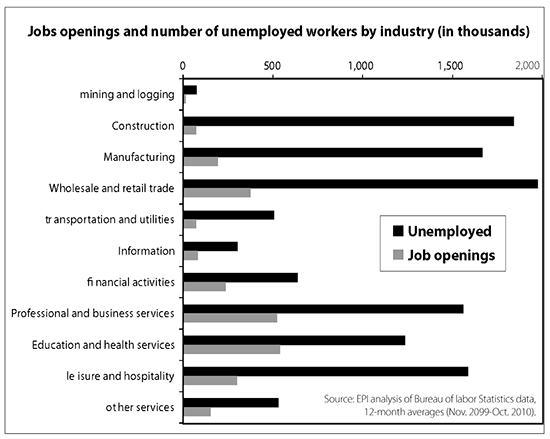Jobless recovery persists
By
Fred Goldstein
Published Mar 13, 2011 11:17 PM
The big-business press and television are hyping the February job numbers as
evidence of a coming turnaround in the recovery for workers. The government
announced that 192,000 net new jobs were created last month and that the
private sector created 222,000 jobs. Thus the unemployment rate was declared to
have gone down from 9 percent to 8.9 percent.
But no matter how much hype is mustered behind these figures — no matter
how much the pundits read good news into a miserable situation — the
jobless recovery continues without letup.
The Wall Street Journal, of all publications, lifted the lid on the truth
concealed in the current statistics.
One key gauge of the labor market’s health — the labor force
participation rate, which measures the percentage of adults who have jobs or
are seeking them — remained stuck at its lowest point since the
mid-1980s.
A low participation rate both saps the economy’s long-term growth
potential and can obscure deeper problems in the labor market. If, for example,
labor force participation today were at the same level as before the recession,
the jobless rate would have been 11.5 percent in February.
In other words, no matter how the government slices and dices the statistics,
millions of workers gave up looking for jobs long ago, and the statisticians of
the capitalist government have no desire to count them. Thus they are not
entered into the calculations of the unemployment rate.
The economy has officially added an average of 136,000 jobs per month since
November. According to the Economic Policy Institute, which bases its numbers
on the Bureau of Labor Statistics, it takes 127,000 per month just to keep up
with new entries into the labor force.
Considering there are 13.7 million people officially unemployed — an
estimated 8 million underemployed and more than 2 million officially counted as
having dropped out — at the present pace of job growth, there will not be
a dent in mass unemployment. By one calculation from the liberal think-tank
Center for American Progress, it would take until 2033 just to get back to 5
percent unemployment!
While there was much crowing about the pitiful figure of 222,000 jobs added in
the private sector, there was no report on how many of them are temporary jobs,
low-wage jobs or short-hour jobs. The bosses have adopted a
“just-in-time” hiring policy of temporary workers who can be
disposed of at any moment.
Furthermore, the media quietly stated that state and local governments laid off
30,000 workers in February. States have cut 82,000 jobs and localities have cut
377,000 jobs since August 2008. And unless the working class can stop the state
and local governments, backed by the bankers and bosses, the plan is to
escalate layoffs of public sector workers.
At the end of it all, there are around 30 million workers still unemployed,
underemployed or who have dropped out and are totally unaccounted for in the
government statistics.
Time for a working-class recovery
The capitalist state, the Federal Reserve, the Treasury Department and the
White House have pumped $10 trillion into the economy, mostly to bail out the
auto industry and the banks, which also get loan guarantees.
Bankers’ profits are higher than ever. Corporate profits are up. The
capitalists are recovering, but for the tens of millions of workers it is still
a jobless recovery.
What is a jobless recovery? It is a recovery of business production and profits
while jobs either continue to be lost or whatever gains take place are minimal.
Under capitalism historically, business recoveries are supposed to be
accompanied by an upsurge in hiring, not job losses or job stagnation.
The first jobless recovery in the U.S. since the Great Depression followed the
recession of 1991. This was followed by a second and much worse one after the
2000-2001 downturn. What the U.S. working class is experiencing today is the
third consecutive jobless recovery. Only this one is far more severe, far more
protracted and shows little sign of abating.
Capitalism has hit an impasse. The more productive it becomes, the fewer
workers it needs and the lower wages it pays.
The class struggle of the workers — to keep the ruling class from
unloading on them the huge debt crisis incurred by bailing out the millionaires
and billionaires — and the fight for jobs are the only way out.
The workers in Wisconsin and all the workers around the country who have
rallied to their cause have set in motion a movement which must grow and spread
so that it can become the spark that lights the fire of mass fightback to turn
the capitalist recovery into a working-class recovery.
Articles copyright 1995-2012 Workers World.
Verbatim copying and distribution of this entire article is permitted in any medium without royalty provided this notice is preserved.
Workers World, 55 W. 17 St., NY, NY 10011
Email:
[email protected]
Subscribe
[email protected]
Support independent news
DONATE


